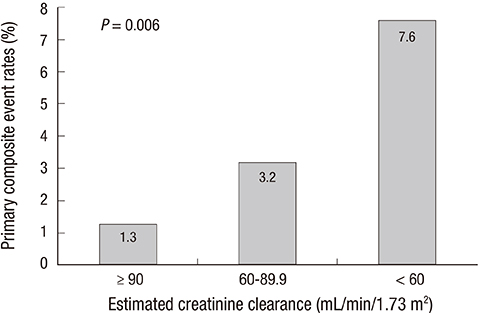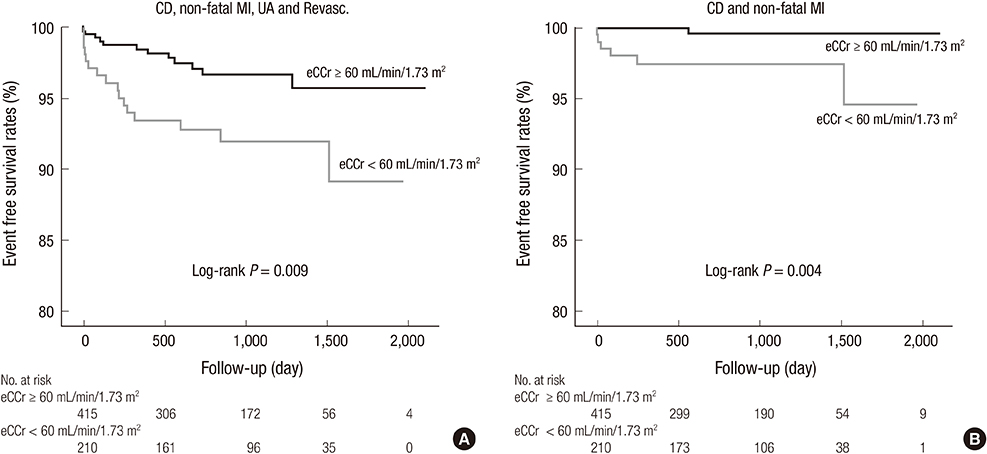J Korean Med Sci.
2015 Sep;30(9):1273-1278. 10.3346/jkms.2015.30.9.1273.
Prognostic Value of Renal Function for Cardiac Events in Patients Without Significant Stenosis on Coronary Computed Tomography Angiography
- Affiliations
-
- 1Division of Cardiology, Boramae Medical Center, Seoul, Korea.
- 2Division of Cardiology, Seoul National University Hospital, Seoul, Korea. kimdamas@snu.ac.kr
- 3Division of Cardiology, Seoul National University Bundang Hospital, Seongnam, Korea.
- 4Department of Internal Medicine, Seoul National University College of Medicine, Seoul, Korea.
- KMID: 2344152
- DOI: http://doi.org/10.3346/jkms.2015.30.9.1273
Abstract
- This study was conducted to determine clinical parameters predicting future major adverse cardiovascular events (MACEs) in patients without significant stenosis on coronary computed tomographic angiography (CCTA). A total of 625 patients with suspected coronary artery disease (CAD) who underwent CCTA that revealed insignificant (< 50%) CAD was reviewed in three cardiac centers. The MACEs including cardiac death, non-fatal myocardial infarction (MI), unstable angina and late (> 90 days after CCTA) revascularization were assessed. During the mean follow-up period of 819 +/- 529 days (median 837 days), there were 28 cases of MACEs (4.5%). In multivariable Cox regression analysis, independent predictors for MACEs were male sex (hazard ratio [HR], 2.40; 95% confidence interval [CI], 1.01-5.69; P = 0.046) and low estimated creatinine clearance (eCCr) (< 60 mL/min/1.73 m2) (HR, 3.07; 95% CI, 1.22-7.74; P = 0.017). Low eCCr was the only independent predictor for hard events including cardiac death and MI (HR, 17.6, 95% CI, 1.44-215.7; P = 0.025). In conclusion, renal function is an independent predictor for cardiovascular events among patients without significant CAD by CCTA. Careful monitoring and preventive strategy are warranted in patients with impaired renal function even without significant CAD.
MeSH Terms
-
Adult
Aged
Aged, 80 and over
Cardiovascular Diseases/diagnosis/*mortality
Comorbidity
Coronary Angiography/*statistics & numerical data
Coronary Stenosis/mortality/radiography
Female
Humans
Incidence
Kidney Diseases/*diagnosis/*mortality
Kidney Function Tests/*statistics & numerical data
Male
Middle Aged
Prognosis
Reproducibility of Results
Republic of Korea/epidemiology
Risk Assessment
Sensitivity and Specificity
Survival Rate
Tomography, X-Ray Computed/*statistics & numerical data
Figure
Reference
-
1. Meijboom WB, Meijs MF, Schuijf JD, Cramer MJ, Mollet NR, van Mieghem CA, Nieman K, van Werkhoven JM, Pundziute G, Weustink AC, et al. Diagnostic accuracy of 64-slice computed tomography coronary angiography: a prospective, multicenter, multivendor study. J Am Coll Cardiol. 2008; 52:2135–2144.2. Miller JM, Rochitte CE, Dewey M, Arbab-Zadeh A, Niinuma H, Gottlieb I, Paul N, Clouse ME, Shapiro EP, Hoe J, et al. Diagnostic performance of coronary angiography by 64-row CT. N Engl J Med. 2008; 359:2324–2336.3. Budoff MJ, Dowe D, Jollis JG, Gitter M, Sutherland J, Halamert E, Scherer M, Bellinger R, Martin A, Benton R, et al. Diagnostic performance of 64-multidetector row coronary computed tomographic angiography for evaluation of coronary artery stenosis in individuals without known coronary artery disease: results from the prospective multicenter ACCURACY (Assessment by Coronary Computed Tomographic Angiography of Individuals Undergoing Invasive Coronary Angiography) trial. J Am Coll Cardiol. 2008; 52:1724–1732.4. Min JK, Dunning A, Lin FY, Achenbach S, Al-Mallah M, Budoff MJ, Cademartiri F, Callister TQ, Chang HJ, Cheng V, et al. CONFIRM Investigators. Age- and sex-related differences in all-cause mortality risk based on coronary computed tomography angiography findings results from the International Multicenter CONFIRM (Coronary CT Angiography Evaluation for Clinical Outcomes: An International Multicenter Registry) of 23,854 patients without known coronary artery disease. J Am Coll Cardiol. 2011; 58:849–860.5. Min JK, Shaw LJ, Devereux RB, Okin PM, Weinsaft JW, Russo DJ, Lippolis NJ, Berman DS, Callister TQ. Prognostic value of multidetector coronary computed tomographic angiography for prediction of all-cause mortality. J Am Coll Cardiol. 2007; 50:1161–1170.6. Andreini D, Pontone G, Mushtaq S, Bartorelli AL, Bertella E, Antonioli L, Formenti A, Cortinovis S, Veglia F, Annoni A, et al. A long-term prognostic value of coronary CT angiography in suspected coronary artery disease. JACC Cardiovasc Imaging. 2012; 5:690–701.7. Gibbons RJ, Chatterjee K, Daley J, Douglas JS, Fihn SD, Gardin JM, Grunwald MA, Levy D, Lytle BW, O'Rourke RA, et al. ACC/AHA/ACP-ASIM guidelines for the management of patients with chronic stable angina: executive summary and recommendations A Report of the American College of Cardiology/American Heart Association Task Force on Practice Guidelines (Committee on Management of Patients with Chronic Stable Angina). Circulation. 1999; 99:2829–2848.8. Abidov A, Rozanski A, Hachamovitch R, Hayes SW, Aboul-Enein F, Cohen I, Friedman JD, Germano G, Berman DS. Prognostic significance of dyspnea in patients referred for cardiac stress testing. N Engl J Med. 2005; 353:1889–1898.9. Kim HL, Park IY, Choi JM, Hwang SM, Kim HS, Lim JS, Kim M, Son MJ. A decline in renal function is associated with loss of bone mass in Korean postmenopausal women with mild renal dysfunction. J Korean Med Sci. 2011; 26:392–398.10. Choi EK, Chun EJ, Choi SI, Chang SA, Choi SH, Lim S, Rivera JJ, Nasir K, Blumenthal RS, Jang HC, et al. Assessment of subclinical coronary atherosclerosis in asymptomatic patients with type 2 diabetes mellitus with single photon emission computed tomography and coronary computed tomography angiography. Am J Cardiol. 2009; 104:890–896.11. Moon JH, Park EA, Lee W, Yin YH, Chung JW, Park JH, Lee HY, Kang HJ, Kim HS. The diagnostic accuracy, image quality and radiation dose of 64-slice dual-source CT in daily practice: a single institution's experience. Korean J Radiol. 2011; 12:308–318.12. Hadamitzky M, Freissmuth B, Meyer T, Hein F, Kastrati A, Martinoff S, Schömig A, Hausleiter J. Prognostic value of coronary computed tomographic angiography for prediction of cardiac events in patients with suspected coronary artery disease. JACC Cardiovasc Imaging. 2009; 2:404–411.13. van Werkhoven JM, Schuijf JD, Gaemperli O, Jukema JW, Boersma E, Wijns W, Stolzmann P, Alkadhi H, Valenta I, Stokkel MP, et al. Prognostic value of multislice computed tomography and gated single-photon emission computed tomography in patients with suspected coronary artery disease. J Am Coll Cardiol. 2009; 53:623–632.14. Anderson JL, Adams CD, Antman EM, Bridges CR, Califf RM, Casey DE Jr, Chavey WE 2nd, Fesmire FM, Hochman JS, Levin TN, et al. American College of Cardiology. American Heart Association Task Force on Practice Guidelines (Writing Committee to Revise the 2002 Guidelines for the Management of Patients With Unstable Angina/Non ST-Elevation Myocardial Infarction). American College of Emergency Physicians. Society for Cardiovascular Angiography and Interventions. Society of Thoracic Surgeons. American Association of Cardiovascular and Pulmonary Rehabilitation. Society for Academic Emergency Medicine. ACC/AHA 2007 guidelines for the management of patients with unstable angina/non ST-elevation myocardial infarction: a report of the American College of Cardiology/American Heart Association Task Force on Practice Guidelines (Writing Committee to Revise the 2002 Guidelines for the Management of Patients With Unstable Angina/Non ST-Elevation Myocardial Infarction): developed in collaboration with the American College of Emergency Physicians, the Society for Cardiovascular Angiography and Interventions, and the Society of Thoracic Surgeons: endorsed by the American Association of Cardiovascular and Pulmonary Rehabilitation and the Society for Academic Emergency Medicine. Circulation. 2007; 116:e148–e304.15. Chow BJ, Wells GA, Chen L, Yam Y, Galiwango P, Abraham A, Sheth T, Dennie C, Beanlands RS, Ruddy TD. Prognostic value of 64-slice cardiac computed tomography severity of coronary artery disease, coronary atherosclerosis, and left ventricular ejection fraction. J Am Coll Cardiol. 2010; 55:1017–1028.16. Russo V, Zavalloni A, Bacchi Reggiani ML, Buttazzi K, Gostoli V, Bartolini S, Fattori R. Incremental prognostic value of coronary CT angiography in patients with suspected coronary artery disease. Circ Cardiovasc Imaging. 2010; 3:351–359.17. Lin FY, Shaw LJ, Dunning AM, Labounty TM, Choi JH, Weinsaft JW, Koduru S, Gomez MJ, Delago AJ, Callister TQ, et al. Mortality risk in symptomatic patients with nonobstructive coronary artery disease: a prospective 2-center study of 2,583 patients undergoing 64-detector row coronary computed tomographic angiography. J Am Coll Cardiol. 2011; 58:510–519.18. Bamberg F, Sommer WH, Hoffmann V, Achenbach S, Nikolaou K, Conen D, Reiser MF, Hoffmann U, Becker CR. Meta-analysis and systematic review of the long-term predictive value of assessment of coronary atherosclerosis by contrast-enhanced coronary computed tomography angiography. J Am Coll Cardiol. 2011; 57:2426–2436.19. Foley RN, Parfrey PS, Sarnak MJ. Clinical epidemiology of cardiovascular disease in chronic renal disease. Am J Kidney Dis. 1998; 32:S112–S119.20. Na KY, Kim CW, Song YR, Chin HJ, Chae DW. The association between kidney function, coronary artery disease, and clinical outcome in patients undergoing coronary angiography. J Korean Med Sci. 2009; 24:S87–S94.21. Go AS, Chertow GM, Fan D, McCulloch CE, Hsu CY. Chronic kidney disease and the risks of death, cardiovascular events, and hospitalization. N Engl J Med. 2004; 351:1296–1305.22. Baber U, Stone GW, Weisz G, Moreno P, Dangas G, Maehara A, Mintz GS, Cristea E, Fahy M, Xu K, et al. Coronary plaque composition, morphology, and outcomes in patients with and without chronic kidney disease presenting with acute coronary syndromes. JACC Cardiovasc Imaging. 2012; 5:S53–S61.23. Virmani R, Burke AP, Farb A, Kolodgie FD. Pathology of the vulnerable plaque. J Am Coll Cardiol. 2006; 47:C13–C18.24. Ehara S, Kobayashi Y, Yoshiyama M, Shimada K, Shimada Y, Fukuda D, Nakamura Y, Yamashita H, Yamagishi H, Takeuchi K, et al. Spotty calcification typifies the culprit plaque in patients with acute myocardial infarction: an intravascular ultrasound study. Circulation. 2004; 110:3424–3429.25. Falk E, Shah PK, Fuster V. Coronary plaque disruption. Circulation. 1995; 92:657–671.26. Wada M, Ueda Y, Higo T, Matsuo K, Nishio M, Hirata A, Asai M, Nemoto T, Kashiyama T, Murakami A, et al. Chronic kidney disease and coronary artery vulnerable plaques. Clin J Am Soc Nephrol. 2011; 6:2792–2798.27. Hayano S, Ishii H, Ichimiya S, Kanashiro M, Watanabe J, Suzuki S, Yoshikawa D, Maeda K, Matsubara T, Murohara T. Renal dysfunction and atherosclerosis of the neointima following bare metal stent implantation. Am J Nephrol. 2013; 38:58–65.28. Kockx MM, Herman AG. Apoptosis in atherogenesis: implications for plaque destabilization. Eur Heart J. 1998; 19:G23–G28.29. Pelisek J, Assadian A, Sarkar O, Eckstein HH, Frank H. Carotid plaque composition in chronic kidney disease: a retrospective analysis of patients undergoing carotid endarterectomy. Eur J Vasc Endovasc Surg. 2010; 39:11–16.30. Pelisek J, Hahntow IN, Eckstein HH, Ockert S, Reeps C, Heider P, Luppa PB, Frank H. Impact of chronic kidney disease on carotid plaque vulnerability. J Vasc Surg. 2011; 54:1643–1649.
- Full Text Links
- Actions
-
Cited
- CITED
-
- Close
- Share
- Similar articles
-
- Normal coronary CT angiography with subsequent adverse cardiac events
- Cardiac CT
- Clinical Utility of Coronary CT Angiography with Stress Perfusion CT in Preoperative Cardiac Risk Evaluation
- Prognostic Value of Normal Exercise (99m)Te-MIBI Myocardial Perfusion SPECT: Comparison with Exercise Electrocardiography and Coronary Angiography
- Accuracy of Three-dimensional Coronary Arteriography by Electron-Beam Tomography




